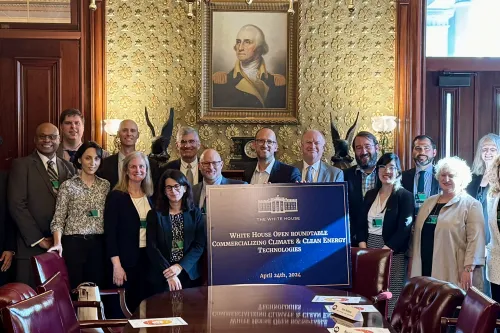An Update on Research Administration
Over the years, two overarching trends have added to the research administration complexity faced by principal investigators at MIT.
First, the fraction of research funding that comes from non-federal sources, including industry and private foundations, has increased substantially, today accounting for approximately 40% of our campus research volume. Second, research agreements themselves, federal and non-federal alike, have grown more complex, due to a range of factors such as new compliance, data privacy, and disclosure requirements.
Many principal investigators (PIs) at MIT now manage more diverse research portfolios composed of more complex individual agreements. In light of these changes, and to better support PIs, in fall 2019 MIT announced an effort to transform its research and sponsored activity enterprise.
In the coming months, on these pages, we plan to provide updates on our progress in enacting this transformation. Today, we offer a broad overview of what we’re working to achieve, along with a brief status report. In future updates, we’ll go into more detail about the issues we summarize here.
At its core, this transformation is about ensuring that researchers can spend as high a proportion of their time as possible on their research.
It is also about ensuring that researchers have the support they need to successfully pursue appropriate funding opportunities, rather than pass them up because of concerns about excessive administrative burdens. Ideally, if we are successful, we should be able to say that our research administration enterprise satisfies the following four strategic imperatives:
First, it is built on a culture of PI service and mutual respect, providing researchers with more personal support and a clearer understanding of expectations, goals, and timelines. Second, it is agile – well-positioned to manage the increasing complexity of agreements and of researchers’ funding portfolios. Third, it is viewed by PIs as a resource and respected partner, not a barrier. Fourth, it supports a seamless process from beginning to end – researchers don’t have to serve as their own general contractors to ensure that grant applications or negotiations with a potential sponsor remain on track.
To build this kind of enterprise, our focus is on what we call the “two Ts”: teams and tools.
Teams
A few years ago, when we were contemplating how to design this new enterprise, a faculty and staff committee proposed various options. These ranged from making modest changes to the former Office of Sponsored Programs, to a more complete overhaul – starting from a clean slate and mapping out the resources and functions that we believed were vital.
Ultimately, it was the latter, more comprehensive approach that we chose to pursue, based on a recognition that working with different types of sponsors requires teams with additional sets of skills and areas of expertise, including ones that we didn’t yet have. Hence we created two new offices, Research Administration Services (RAS) and the Office of Strategic Alliances and Technology Transfer (OSATT).
RAS focuses primarily on grants and contracts with U.S. federal, state, local, and some nonprofit sponsors. Its professionals are experienced in managing the deadline-driven application processes of the federal government, the considerations when PIs are part of a multi-institution collaboration sponsored by the federal government, and staying current on federal agencies’ rapidly evolving compliance and disclosure requirements. RAS also supports the important post-award phase when sponsored agreements connect funding to the MIT accounts that PIs use to support research team costs or when the PI seeks a no-cost extension from a federal sponsor.
OSATT focuses on agreements with industry, industry consortia, international sponsors, and – along with RAS – select nonprofits. Professionals in OSATT bring experience and expertise in supporting PIs who pursue new opportunities for external engagement and managing the risks that come with those opportunities, such as preserving the PI’s right to publish research outcomes while also supporting any interest in pursuing commercialization. Many PIs at MIT work in highly collaborative environments (across other institutions or multiple sponsor types), which we consider a strength; but this also includes complexity for the PI. Here, OSATT supports the PI’s role in being aware of and appropriately managing those implications.
The RAS and OSATT teams work closely with each other and with colleagues from other offices across the Institute, including the research compliance and systems and support teams in the Office of the Vice President for Research; Office of General Counsel; Office of the Vice President for Finance; Resource Development; and more.
With a PI service orientation, the objective is that professionals within RAS and OSATT support researchers by pulling in resources from other parts of the Institute, as needed.
That’s what we mean when we say that PIs should not have to be their own “general contractors.” For this approach to succeed, we as faculty in our PI roles also need to engage staff colleagues in research administration roles with respect for their expertise and workload, just as we expect the same when seeking administrative services and support.
Additional critical partners are research and administrative staff in departments, labs, and centers, who have important responsibilities in research administration. Together, all stakeholders – PIs and staff members at both the Institute and local levels – contribute to the shared mission of submitting high-quality proposals, managing compliance risks, and fostering productive external engagements.
Our objective here has been simply to give the lay of the land. In a future update, we’ll describe in more detail how these new organizational structures are intended to improve the everyday experience of PIs.
Tools
The other one of our two “Ts” is tools. We need to work continuously to upgrade the tools available to support research and the administration of sponsored activities. An example is the recent launch of a new portal for requesting non-disclosure agreements (NDAs) and data use agreements (DUAs).
Rapid growth in the quantity and complexity of NDAs and DUAs has been a real pain point for faculty in recent years. Following several months of discussions with staff and faculty about how to simplify the processing of these agreements, OSATT launched the new portal in January 2022. It provides an easy way to stay updated on the status of requests and connect to the colleagues who facilitate these agreements.
An initiative for which planning is underway is the development of a new one-stop research dashboard. It will create a single access point to all information about research and sponsored activity for researchers and research administration teams, consolidating information that is stored in various existing systems at MIT. We will provide more details in a future update.
Progress
The pandemic caused a delay in executing the plan we laid out in 2019, but we are again making progress on both the teams and tools aspects of the plan.
In fiscal year 2021, despite the fact that RAS was forced to become a fully remote operation, its grants and contracts team reviewed and submitted a total of 3,344 proposals (down less than 1% from fiscal year 2020) and processed 1,145 new awards (down just 3% from fiscal 2021). In fiscal year 2022 to date, the numbers are up compared with the same period last year.
OSATT finalized over 250 research agreements with non-federal sponsors and over 700 other research-related agreements vital to individual PIs in fiscal year 2021.
OSATT also took point in partnership with PIs and other MIT offices to successfully conclude a number of important new Institute-wide agreements with a range of companies such as Accenture, Amazon, and Takeda, as well as many School- or department-level agreements with organizations key to their research pursuits. To test new approaches in partnership with faculty and research administrators in DLCs, OSATT has also launched targeted programs over the past year. For example, partnership with the Department of Chemical Engineering this academic year has helped OSATT, RAS, and the DLC test and improve administration of industry-sponsored research for PIs.
We have also continued building the RAS and OSATT teams. After the hiring freeze that began in early 2021, we resumed recruitment and filled several key positions. Notably, we are pleased to announce that RAS has a new director, Vivian Holmes, who joined MIT in February and brings years of research administration experience at peer institutions. We continue to actively recruit and hire experienced professionals for the OSATT team, with a strong focus on services that help PIs convert ideas to agreements that enable impactful new MIT research programs.
Ad Hoc Faculty Committee
We are standing up a new committee to inform future progress and further execution. The Ad Hoc Research Administration Faculty Advisory Committee is charged with providing advice and feedback on administrative aspects of the MIT research enterprise, including the learnings from Task Force 2021 and Beyond. Chaired by Professor Rob Simcoe of Physics, with members from all five Schools and the College, it will report to the Provost, Vice President for Research, and Faculty Chair. It will operate initially for one year, at which time the leadership will assess the benefit of its continuation.
Conclusion
This will be the first of a few updates on the transformation of our research and sponsored activity administration enterprise. We appreciate the interest expressed by PIs regarding what they can expect from RAS and OSATT. We’ll provide additional details and status about the research dashboard under development. And we’ll discuss our work to support researchers with compliance requirements, particularly those related to disclosure requirements to federal agencies, and data security and privacy enhancements. In the meantime, as always, we invite your feedback.
Editor’s Note: See “M.I.T. Numbers” for a chart of campus research revenues as percentages by sponsor type, averaged over five fiscal years, 2017-2021.
Originally posted in the MIT Faculty Newsletter, February 2022.
Subscribe to our newsletter
Stay updated with the latest insights and events with our quarterly newsletter.


